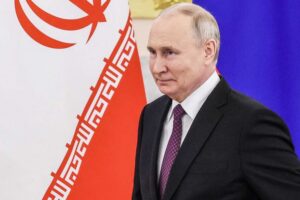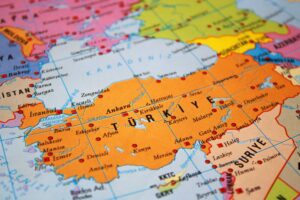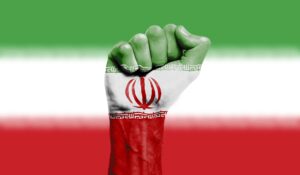Special Feature with Dr. Nina Ansary, Member of MENAF’s International Advisory Board
Dr. Nina Ansary’s ‘Anonymous Is a Woman’: A Global Chronicle of Gender Inequality promises to break our historical amnesia through a sweeping account of women throughout history who have been ‘forgotten’ by virtue of their gender. It extends a simple argument, or what Ansary calls an ‘indisputable truth’: that throughout history, women have been disregarded. It is through an exploration of fifty accomplished women across borders and history that we are reminded of the near universal subjugation that women have experienced throughout time.
The book’s commendably cosmopolitan coverage of women from around the world comes to colour our understanding of what it means to speak as a ‘feminist’ in the 21st century. Ansary speaks of a ‘critical mass’ of women and the book casts a light on some of the particular – and oft-neglected – faces that constitute this mass (aided all the more by Petra Dufkova’s stunning illustrations). Prior to this rich account, Ansary considers the histories of the women’s movement and where it finds itself today. Her discussion of how women of colour and working women have been excluded from Euro-American feminist discourses is brief: an affirmation of these critiques, accompanied by the claim that we should ‘nonetheless’ value those discourses for their broader contributions to the feminist movement.
Ansary ambitiously weaves aspects of Chinese philosophy to make a case for gender parity. It is a convincing case that incorporates philosophy with empiricism – we are given clear statistics and studies to ground the argument. However convincing, there is a clear instrumentalist approach driving these claims – and their implications are worth considering. To strengthen the case for gender parity in the workplace, Ansary cites a McKinsey report whose “findings reinforce that there is a clear correlation between diversity and profitability.”
More potent is Ansary’s depiction of the women we have a duty to remember. She takes us to the 15th century Kongolese Kingdom, where Beatriz Kimpa Vita challenged the boundaries of traditional Kongolese society and European Catholic colonisers through her work as a healer and advocate for the restoration of the kingdom of Kongo. Jeanne Villepreux-Power, a self-taught marine biologist and inventor of the aquarium, is plucked from 17th century France to remind us about the importance of supporting women in STEM fields. Mocked for her naivete and belief in the prospects of peace through diplomacy, the first female recipient of the Nobel Peace Prize, Bertha von Suttner, is remembered for “[declaring] war on war” in her pseudonymously published volume Lay Down Your Arms (1889). The critical intersection of feminism and caste is explored through a profile of Savitribai Phule, a social reformer and poet born into a low-caste family in 19th century India who started a school for lower-caste girls and initiated the practice of Satyashodhak marriage, which requires couples to take an oath of education and equality. Phule was subject to extensive backlash and public abuse for her advocacy work, much like von Suttner. Backlash and abuse seem to be a shared theme amongst the experiences of prominent women. Bad attention or no attention at all, appears to be the binary determining the reception they receive; the positive attention lent to them by Ansary in this volume is a welcome changing of the tides.
The book’s final profile is of Alice Ball, the first African American woman to teach chemistry at the University of Hawaii, and it serves as a testament to its most enduring message: that as aware as we may be of the obstacles women continue to face, it is also worth taking time to recognise progress where it has been made – progress we can see as women make strides across societies, and use their gains to uplift women everywhere. Ball, for example, discovered the most effective treatment for leprosy at 23 and died shortly after; her white male colleague took credit for her work for many years and named the treatment after himself, until correcting the record in 1922. In 2000, Hawaii’s first woman of colour to serve as Lieutenant Governor, Mazie Hirono, declared the 29 of February ‘Alice Ball Day’; she used her position to recover one forgotten woman from history, just as Ansary does with the fifty women in this volume.
MENAF: What were your intentions with writing this book? Why reach back in history?
The pushback on women’s rights in countries like Iran are powerful reminders not to be complacent in our assumption of linear progression when it comes to gender equality.
DR. NINA ANSARY: In my work as a historian and women’s rights advocate, I have chronicled centuries of gender disparity. Wage discrimination, lack of access to education, legal and professional barriers embedded in society continue to keep women and girls from access to equal rights and opportunities. The result is a world that reflects the vision and capabilities of only a fraction of human potential. The book takes readers on a 4,000-year historic journey through the lives of fifty forgotten female innovators to expose the roots and manifestations of systemic gender discrimination and the myriad ways it permeates nearly every aspect of modern life. The intention for writing this book is to show that although there has been significant advancement, there has also been setback. As a woman born and raised in pre-revolutionary Iran during a relatively liberal social period, I left in the immediate aftermath of the Islamic Revolution. From afar, I witnessed my birth country radically shift and with it the lives of its women, who for over four decades now, have challenged the gender discriminatory laws and fought to regain their rights and their right to self-determination. The pushback on women’s rights in countries like Iran are powerful reminders not to be complacent in our assumption of linear progression when it comes to gender equality. The book also addresses vulnerabilities in the social, political and economic system and how to move forward in a way that builds beyond narrow reforms, especially among the marginalized and vulnerable segments of society.
As such, reaching back in history is important as it provides context, including the ebb and flow of global statistics, data, trends, policies, laws, and narratives that have shaped centuries of ideological bias and perspective. Furthermore, it allows for a more comprehensive examination and analysis of the social, political and economic systems past and present, including circumstances enabling progress as well as setback despite advancement.
How does your academic background inform your work as an activist?
In many ways, academia can be a site for activism in its ability to produce knowledge as a means to inform social change. Bringing scholarly training to real-world application involves undertaking research that supports and/or informs activism, and in turn serves as a base given that scholarship fosters useful skills in writing, argument, public speaking and critical reflection. Such a background may additionally contribute to policy discourse through participation in public debates and/or direct submission to policy makers. In fact, the term “Action Research,” describes methodologies that simultaneously involve pursuing social change. This is typically participatory, through alliances with like-minded individuals, organizations, communities and various other networks working towards a collective purpose.
In the book, you cite the “scope and composition” of the women’s movement as its greatest strength. What is the scope and composition? Why is it so important?
To clarify for the reader, I was referring to the “scope and composition” of the global women’s movement. With its commitment to egalitarianism, the core of the movement itself is expansive as the struggle is on behalf of all women contesting patriarchal ideology and challenging an inferior status based on gender. Here we are talking about centuries of resistance by a global community of women demanding change, equal rights and opportunities. History has shown that the most successful social movements are not only large but also unified in their quest to bring about meaningful and lasting change. This journey, therefore, requires building in size and scope over time, including expansion of agenda as changing circumstances dictate. When it comes to the women’s movement, we are a collective united in our determination and belief that half the world’s population should be on equal footing with the other half. Recall the 2017 Global Women’s March where an estimated five million people came together. In the United States alone, there were more than 400 separate marches across the nation. The March included women of all ethnicities, ages, socio-economic backgrounds, political affiliations and gender identifications. It also drew a sizable group of men as well. You have to ask yourself why the turnout was so high? Because at its core, the struggle for women’s rights is not just about women’s rights – it’s about human rights – the right for all people, regardless of gender, to achieve and to contribute, to exercise free will and to feel safe. History has proven that social movements tend to achieve tangible results when they reach a critical mass. It is, therefore, specifically in this regard that the women’s movement and its ever-expanding scope and composition are its greatest strength.
The concept of ‘gender apartheid’ is something you mention with reference to the situation of women in Iran. What do you mean by this term?
It can be said that women in Iran are caught in a system of gender apartheid through legal mandates that relegate them to a subordinate status, depriving them of their basic human rights.
In its most basic definition, the term “gender apartheid” refers to the economic, social and sexual discrimination based on an individual’s gender or sex. Iran is a country that ignores international treaties and standards. Adding to this are the plethora of patriarchal mandates and gender discriminatory laws and practices embedded in the constitution and penal code. Women in Iran are shrouded in restrictions in practically every area of life – from clothing, employment, inheritance, divorce and child custody. Furthermore, laws fail to legally protect them from a multitude of injustices, including child marriage, sexual and domestic violence. Therefore, it can be said that women in Iran are caught in a system of gender apartheid through legal mandates that relegate them to a subordinate status, depriving them of their basic human rights. Iran continues to score near bottom of the in the World Economic Forum’s Global Gender Gap, ranking 148th out of 153 countries. That being said, despite institutionalized discrimination and severe rights violations, women comprise 60% of university graduates and have excelled beyond their circumstances. The post-revolutionary years have witnessed the birth of a grassroots feminist movement. Adding to this landscape, is a generation of fearless and resilient women who are distinguished not only for the myriad of clever ways they have been able to circumvent the system but also for their outstanding accomplishments in practically every field. This is undoubtedly a testament to their courage, resilience, and determination to cross the finish line.
As part of the Iranian diaspora, how do you see your relationship to the contemporary women’s movement in Iran?
For women in Iran, the road to freedom, equality and human rights is one which is undoubtedly paved with tremendous obstacles. For over four decades, countless courageous activists and lawyers have challenged discriminatory laws, often times paying a high price as their peaceful activism continues to be criminalized. As an example, prominent human rights attorney Nasrin Sotoudeh was issued a 38-year prison sentence and 148 lashes for defending the women protesting Iran’s mandatory veiling law. In fact, her sentencing set a new tone for the judicial repression of human rights. Ms. Sotoudeh recently stated “In Iran we are always prisoners. You might think I’m exaggerating but when our main concern is the absence of justice, our society being imprisoned or not does not make a difference.” Adding to the current landscape, is the ideological disposition of the Supreme Leader who believes that “gender equality is one of the biggest misconceptions of Western thought.” As part of the Iranian diaspora, speaking openly and persistently against injustice and human rights violations on behalf of Iranian civil society is crucial given that the regime routinely attempts to silence its own people through various intimidation tactics and/or coercive measures. Raising awareness within the international community by giving activists in Iran a voice is of monumental importance, especially given that the majority of Western media outlets have a tendency to focus on issues outside the purview of rights violations. In this regard, it is imperative for the Iranian diaspora to show solidarity in a manner that brings attention to continued violations, especially given the recent wave of peaceful dissent which has only intensified state crackdown.
In the Middle East, women’s movements can be undermined by those who dismiss feminism as a Western transplant. I found the profile of Rabi’a Balkhi to be particularly interesting because it dispels that idea and speaks to the importance of local historical figures who can empower grassroots movements. What value do stories like hers have for women’s rights in the region?
Rabi’a Balkhi is believed to be the first female poet in the history of New Persian poetry. (10th century). She was jailed by her brother for falling in love with a slave and daring to write love poems. Her stoicism and defiance in a male-dominated culture continues to inspire a nation rife with gender-based violence and her enduring legacy lives on as women continue to fight for their rights.
At its core, feminism is about the quest for freedom and equality from oppression. In its broadest definition, feminism refers to the array of movements and ideologies advocating women’s rights on the grounds of sexual equality.
In terms of “feminism” viewed as a “Western transplant,” it is important to note that at its core, feminism is about the quest for freedom and equality from oppression. And in its broadest definition, feminism refers to the array of movements and ideologies advocating women’s rights on the grounds of sexual equality. Therefore, whatever “label” one chooses, depending on the region, the end goal is the fundamental right to an equal status and the right to self-determination. The overarching value of stories like Rabi’a highlight centuries of struggle against injustice and institutionalized discrimination. They also show the importance of women’s voices challenging “norms,” the boundaries of gendered expectations and the “prescribed” role for women in society. Furthermore, the fact that centuries ago women in every part of the world were fighting for the same cause and at times even paying a high price, highlights a universal theme which transcends boundaries. These stories are also an important reminder of regional differences and the importance of understanding and respecting cultural and historical complexities of what essentially constitutes varying definitions of “womanhood.”
The book ultimately strikes a tone somewhere between hope and despair – reflecting both the strides made and the barriers facing women around the world today. Like you mention, this is a world where women in Saudi Arabia have finally been given the right to drive. But it is the same world where Saudi women’s rights activists like Loujain al-Hathloul have been jailed for 1001 days.What kind of tone were you hoping to strike?
Although there has been tremendous advancement, we must not lose sight of the fact that worldwide, women are still in the midst of an arduous journey toward equality. Understanding the global gender gap is key and progress as evidenced by the statistics, facts and figures reveal the challenges that need to be overcome. Therefore, while I choose to remain hopeful and on the bright side of optimism, it is my job to present an accurate portrait of the current landscape and potential avenues towards achieving the overall objective.
100% of proceeds from the sale of Anonymous Is a Woman will be donated to various not-for-profit organizations including the Center for Human Rights in Iran. In fact, all proceeds from the sale of your previous book, Jewels of Allah, went to charitable institutions too. What role does charity play and how do you select the initiatives you support?
While it is of crucial importance to advocate and work towards bringing about changes in policy and practice, it is equally important to build and maintain a sustainable infrastructure that is able to facilitate transformation. Philanthropy constitutes an essential component as investing in human rights, including the rights of women and girls is key to building an institutional base and such initiatives require long-term core funding. From a strictly personal standpoint, giving back has been an integral part of my upbringing and only makes sense for it to be a primary part of my platform. The initiatives I support have to align with my mission and overall objectives and this includes having the potential to impact change.
You studied sociology as an undergraduate, obtained your M.A. in Middle Eastern, South Asian and African Studies and your PhD in History from Columbia University. What guided you towards social sciences and how did you start your work as an activist?
Social sciences provide context for how societies function as a whole, broadly exploring a multitude of fields from education, psychology, law, to economics and politics. In particular, I found the study of sociology and its multi-disciplinary approach to behaviour including cross-cultural relations and social structures to be fascinating. Broadly speaking, the range of knowledge within these disciplines cover a wide spectrum providing integrated perspectives in the social, economic and political arenas, as well as cultural, religious and historical complexities. In my line of work, the combination of these studies provides invaluable insight into social movements, informs policy, legislation, and the impact of non-governmental organizations to name just a few. I began my work as an activist after having earned a PhD. in history. My doctoral thesis focusing on the history of the women’s rights movements and the unanticipated factors contributing to the birth of a feminist movement in post-revolutionary Iran, motivated my journey both as an author and activist.
You have been at the forefront of women’s rights activism for years, having interacted with international counterparts at the platforms of renowned universities such as Columbia, Harvard, the LSE, Oxford and Cambridge, as well as multilateral conferences, think tanks, the United Nations, and even popular media outlets. Based on these interactions and your own insight, what is your overall impression of the challenges that the advancement of women’s rights faces in the global community?
Currently the gender gap score stands at 66.8% and to date no country has achieved gender parity. According to the latest Global Gender Gap report (2020), at the current rate, parity will not be attained for another 99.5 years.
Overall, the challenges range from discriminatory policies, laws and practices including wage discrimination, lack of access to education, legal and professional barriers. At the same time, racial, ethnic and socioeconomic discrimination places minority women at even more of a disadvantage. In countless nations, the inferior status of women has been codified in law and in other countries discrimination takes a more insidious form, manifesting in claims that women are less “biologically” qualified” in certain fields such as math or science.
A more specific example of ingrained bias relates to women’s representation in the STEM fields, which globally stands at less than 30%.
According to the latest statistics by the World Bank, worldwide women have only three-quarters of the economic rights of men and on average only three-quarters of the legal protection; constraining their ability to get jobs, start businesses and make economic decisions that are best for them and their families. Furthermore, inadequate legal measures and legislation cause women and girls to be left vulnerable when it comes to harmful practices such as sexual harassment, child marriage and domestic violence. As mentioned earlier, while we are definitely making progress, we cannot remain complacent in our assumption of linear progression when it comes to women’s rights. Take for example, the United States, considered to be at the forefront of equal rights. In 2019, the US ranked 51st out of 144 countries covered in the World Economic Forum Global Gender Gap Report. Even more alarming is how the US has fallen twenty-three places since 2015 when it 28th. And according to the most recent statistics (2020), the US has yet again dropped in the rankings and now comes in 53rd place behind Bangladesh, Serbia, Zambia and Cuba.
Aside from the ethical argument, the advancement of women and girls is essential for sustainable development.
Aside from the ethical argument, the advancement of women and girls is essential for sustainable development. Therefore, from a strictly economic standpoint, we could achieve a ‘gender dividend’ of $172 trillion by closing gaps in lifetime labor earnings between men and women.
To take this argument one step further, sustainability is more than just women’s advancement. According to numerous studies, diversity in any field is a huge asset as diverse teams outperform homogenous ones. Therefore, if we are to reap the benefits of a more equitable world, we need to proactively work not only to fight for gender equality but also for diversity and inclusion.
You conclude by stressing the importance of stopping this cycle which inhibits women and girls from realizing their full potential. What measures are needed to stop this cycle?
Systemic change requires targeted and collective action and consistent work on parity and equality. This includes a combination of legal reform, effective policymaking, gender budgeting, quotas political will and partnership between the private sector and human and women’s rights organizations. Furthermore, there needs to be cooperation within the global community in order to address the multitude of obstacles including but not limited to inadequate access to education, wage discrimination legal and professional barriers as well as harmful practices such as child marriage, sexual harassment and domestic violence. This process entails investing in a solid care infrastructure, addressing the multitude of legal loopholes and insufficient legislation and challenging the invisible barriers – layers of stereotypical assumptions and popular myths regarding women’s capabilities.
How did the COVID-19 pandemic affect the momentum of the women’s rights agenda? Where did the most crippling setbacks occur and what strategies can be applied to reverse the regressive trends?
The COVID-19 pandemic threatens to derail progress toward women’s rights and gender equality. This is especially true for 264 million women and girls who live in conflict and fragile settings, where pre-existing gender inequalities and patriarchal norms are exacerbated in times of crisis. As an example, globally child marriage is rampant. While in 2019, an estimated 12 million girls were forced into marriage before the age of eighteen, in 2020 the number stood at 12.5 million. It is estimated that an additional 2.5 million girls are at risk of marriage by 2025 because of the pandemic – the greatest surge in child marriage rates in 25 years. Child marriage has devastating health and socio-economic outcomes, trapping girls in a cycle of poverty, gender inequality and disempowerment at all levels. Not to mention, the huge loss of their collective potential which impacts the economy and workforce for generations. There has also been a surge in domestic violence with 243 million women and girls (aged 15-49) subjected to sexual or physical violence by an intimate partner.
Additionally, some 130 million girls worldwide were already out of school before COVID-19. It is now estimated that more than 11 million girls may not return to school in the aftermath of the pandemic. A widening education gap has serious implications for women, including a significant reduction in earnings. In the workplace, women-dominated industries have been hit the hardest, with women losing jobs at a disproportionate rate. While women make up 39% of global employment, they account for 54% of overall job losses. Before the crisis, the World Economic Forum had predicted that it would take another 257 years to reach economic parity between men and women. This figure will likely worsen if both immediate and long-term measures are not taken as women’s jobs have been 1.8 times more vulnerable to the crisis than men’s jobs. Some of the reasons for the greater effect on women include:
- The virus is significantly increasing the burden of unpaid care work.
- Globally, 70% of health workers and first responders are women, and yet, they are not on par with their male counterparts. At 28%, the gender pay gap in the health sector is higher than the overall gender pay gap of 16%.
- Women are disproportionately more in the informal economy, have less access to social protections and make up the majority of single-parent households.
Taking immediate action to counter these affects could add $13 trillion to the global GDP in 2030 compared with the gender-regressive scenario. A middle path – taking action only after the crisis has subsided rather than now – would reduce the potential opportunity by more than $5 trillion. If no action is taken, the global GDP growth could be $1 trillion lower in 2030 than it would be if women’s unemployment simply tracked that of men in every sector. Economic policy imperatives require government investment in the care economy, solid reforms in legislation, and adoption of tax policies that not only encourage women to work but also finance a better compensated childcare industry.
Globally, response and recovery efforts require collective action which includes women’s equal participation and representation in all areas of decision-making and adoption of a gender lens to all response programming in order to ensure that efforts consider and adjust for the gendered impacts of the pandemic. If we are to bring about meaningful change, we can look at this crisis as an opportunity to reassess our priorities and to rebuild beyond narrow reforms of the past as well as an opportunity to rebuild better and stronger.
Anonymous Is a Woman, Revela Press/March 2020)
Bookcover Artwork by Iranian Artist Leyli Rashidi Rauf
100% of all proceeds from the sale of the book will be donated with the primary recipients being The Center for Human Rights in Iran, a New York-based 501 (c)(3) non-profit, non-partisan organization dedicated to the protection and promotion of human rights in Iran; and The London School of Economics Centre for Women, Peace and Security, an academic space for scholars, practitioners, activists, policy-makers, and students to develop strategies that promote justice, human rights and participation of women in conflict-affected situations around the world.

















